Thump!
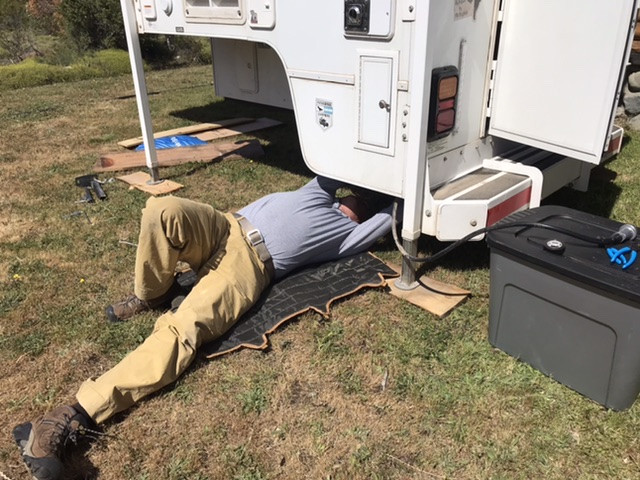
On our way south out of Trevelin late one Saturday afternoon we were winding our way along washboard roads up and down some hills on our way to the Valle Corcovado. Lynnette was driving and I was dozing when I awoke to a “thump” on the vehicle that sounded like a big rock striking the chassis. We hear this all the time so it was not an alarming event. Lynnette looked in the rearview mirror and saw what she thought was a rock as we continued along.
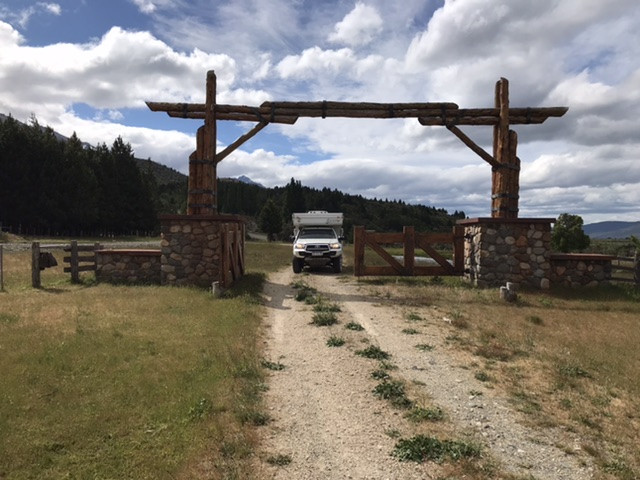
Upon our arrival to the Estancia Poncho Morro I exited the vehicle to open the gate. As Lynnette drove past I noticed our camper auxiliary power cord, which normally plugs into the camper from the truck chassis, hanging loose and frayed, dragging behind the vehicle.
Shit.
Further inspection revealed the gray water storage tank had departed the underside of the camper and had thus unplugged the cord, which had drug along the gravel road for untold kilometers.
The end of the cord now resembled a short vase of colorful flower stems rather than the neat, male end of an auxiliary trailer plug it had earlier in the day
Once again, we were arriving at a place strange to us late in the afternoon and now we had a mild bit of panic to go along with the typical set of unknowns.
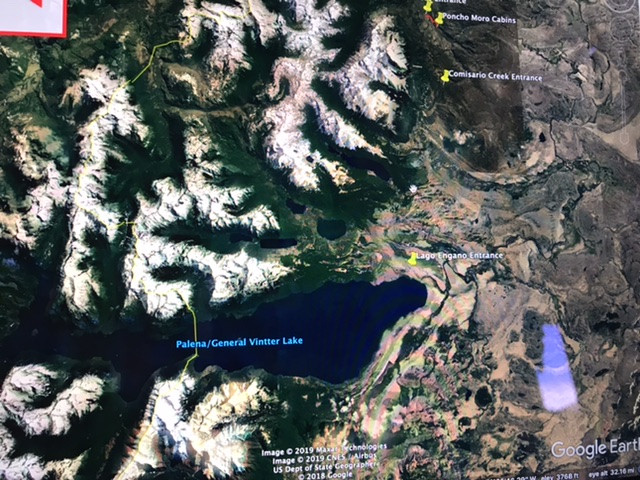
Rance at Patagonia River Guides had told us how to get here to the Estancia Poncho Moro and, through detailed discussions using Google Earth as a visual tool, we had mapped out our arrival and photographed the screen of his computer so we could understand what we needed to know about the estancia and it’s internal road network.
We debated turning around immediately to search for and recover the tank, if possible. We decided then and there the best strategy would be to find the Estancia house, remove the camper using the lift jacks, then return along the 75 km road having the advantage of more speed without the weight of the camper. Besides, the damaged cord also transferred signal from the tail lights of the truck to the tail lights on the camper chassis. We had no tail lights and darkness was closing in.
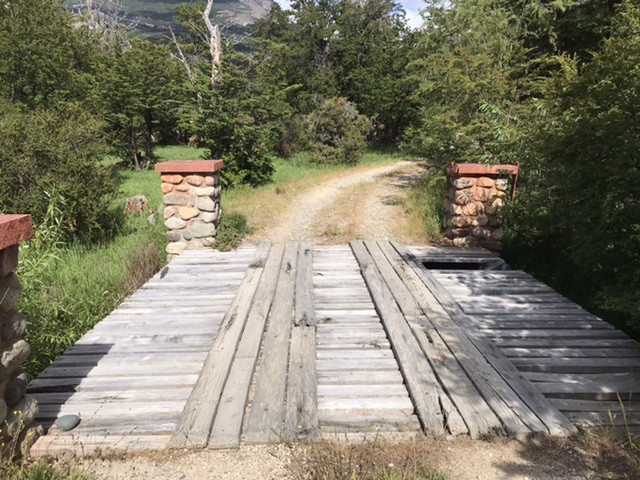
We crept along into the estancias overgrown roads and came to a bridge. The wood was dry rotted and broken in places. Getting out of the vehicle, I got on my hands and knees to look under the bridge and inspect it. It had steel pipe supporting the tread area under the wood. We drove across, hearing crunching, crackling and flapping as the wood took the weight of our vehicle. It was a bit unnerving.
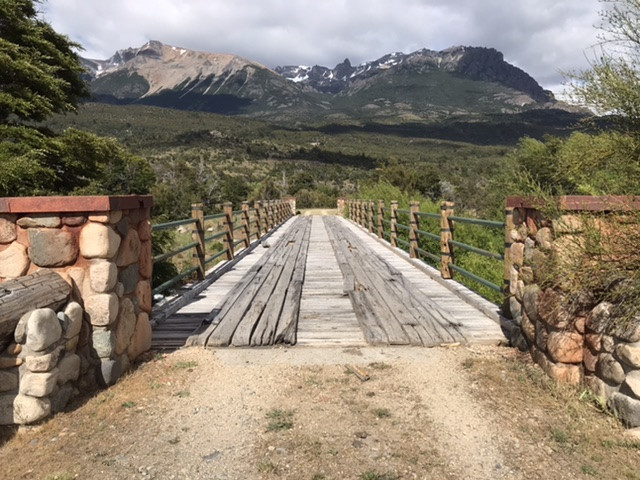
We then came do a second bridge crossing the raging Corcovado river. This bridge was four times as long as the first and looked to be just as rotten. Again, I got out of the vehicle to inspect the underside of the bridge and found steel right where it needed to be. We proceeded with our teeth gritted and our spines stiff and heard the same crackling sounds. We rolled-down our windows and kept our seatbelts off for good measure.
We came to and crossed a third small bridge then the road split. We wondered if we were going the right way or had gone too far when we came to a fourth bridge. The canyon seemed to be narrowing so we got out of the vehicle and turned it off, preparing to walk for a recon. We immediately heard a generator so we got back in the truck and moved along the road towards the sound.
We came to a beautiful log cabin on the side of the river; the smaller of two cabins described to us earlier by Rance. A 10 kw generator was rumbling behind it. The generator almost drowned the sound of the river. We knocked on the door and, getting no answer, walked in to find an interior made of amazing artisanal craftsmanship. An AM radio was crackling out a Spanish language station and there was a pot on the stove, boiling someone’s dinner. We were told they were two cabins, a small one and a larger, lodge-style estancia house. A caretaker was expecting us. We figured we were in the right place.
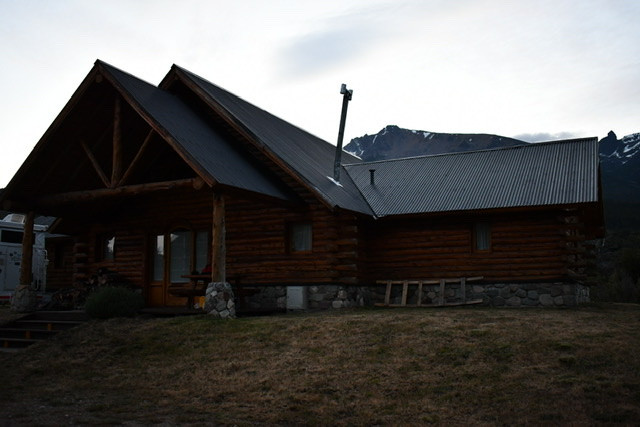
We got back into the truck, honked the horn several times then continued along the road. A couple curves and in short order we came face-to-face with the main Estancia house. It was made of logs and stunningly beautiful. The caretaker, Nico greeted us coming the other way in his battered 1988 Peugeot pick-up truck. He’d heard our horn. We got out and made greetings.
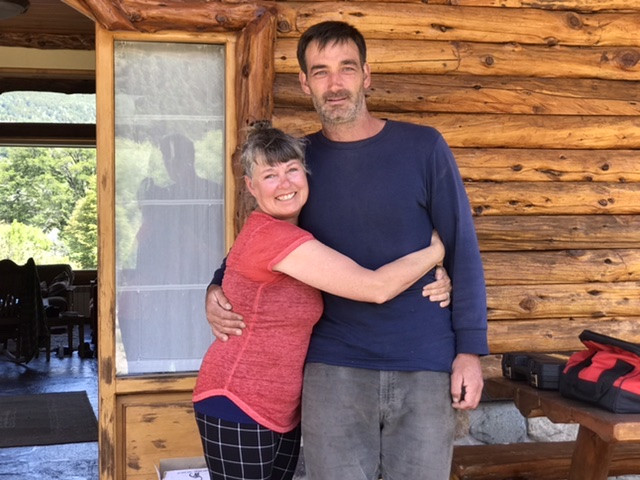
Nico is a tall, strong man with a kind face and intelligent eyes. He is the brother of one of our favorite guides at PRG, Adolfo. We were told by Rance he spoke almost zero English. Therefore, in my see-spot-run Spanish I proceeded to tell the tale of losing our tank and needing to remove the camper then return along the road to find it. I then asked if he would go immediately in his own vehicle, because he could go soonest and faster, with us paying the gas, to see if he could find it. We knew that every moment the tank sat on the road passerby’s were more likely pick it up and take it away. Nico said he understood completely. I reminded him his dinner boiled on the stove. “Si” he said “Mi comida enfuego! Voom!” (My dinner is on fire!) he said with a laugh, an explosive gesture and a twinkle in his eye as he started towards his cabin to turn off the stove heating his dinner before speeding away on the mission.
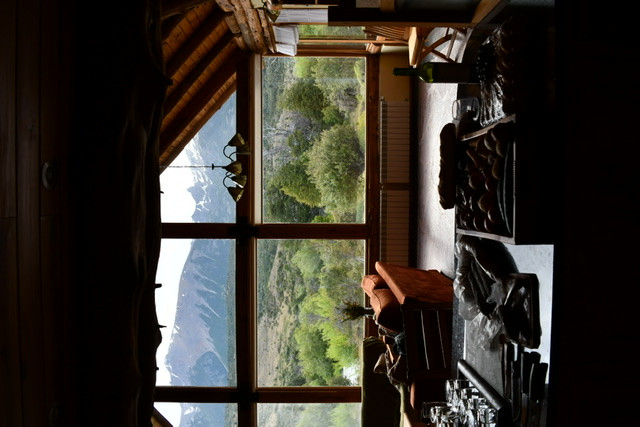
Lynnette and I then took stock of where we were. Looking around us, we were ensconced in a beautiful valley, one of the last range of mountains of the Andes before they mellowed into the Patagonian desert. We were at the steps of this beautiful log home and we entered it. The interior featured red flagstone and contrasting jet slate floors. A massive gray flagstone & log fireplace stood in the main room and everywhere were custom scribed logs of a knotty Cypress that grows in the local area. Most impressive of all, the entire front wall was glass and the Andes loomed large before us. Realizing there was nothing we could do except make ourselves comfortable and wait for the morrow and/or Nico’s news, we lit the prepared fire in the fireplace and brought in our groceries.
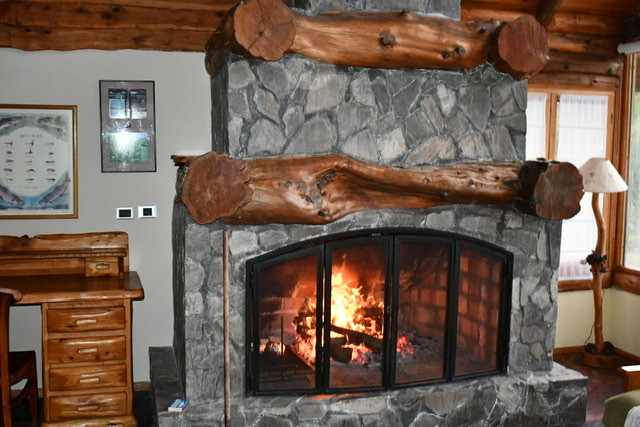
Woe was we, having a glass of wine, feeling the heat from a roaring fire, watching the sunset over the Andes as the clouds poured over them from Chile before dissipating in the dry Argentine air.
We heard Nico return late. When we saw him the next morning he told us he’d gone all the way back to Trevelin and saw nothing resembling our tank. We concluded then that we really didn’t need the gray water tank. It wasn’t like we were going to let sewage dump all over the Argentine countryside, we were talking about dishwater and hand-basin water. 10 billion cattle and sheep were doing far greater impact to the local ecology than two gringos washing their faces and a few cups and bowls. If we were to stay in a campground, we had a Tupperware tub to catch the gray water, which we will then politely pour down a nearby drain.
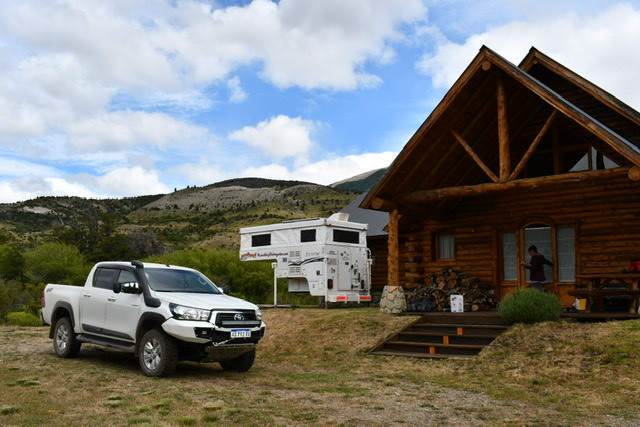
We had arrived on a Saturday, and there wasn’t anything we could do until Monday when the auto parts stores opened, so we spent the next couple days relaxing, resting, cooking asado with Nico and taking small adventures in the local area. Somehow, the urgency of the problem diminished.
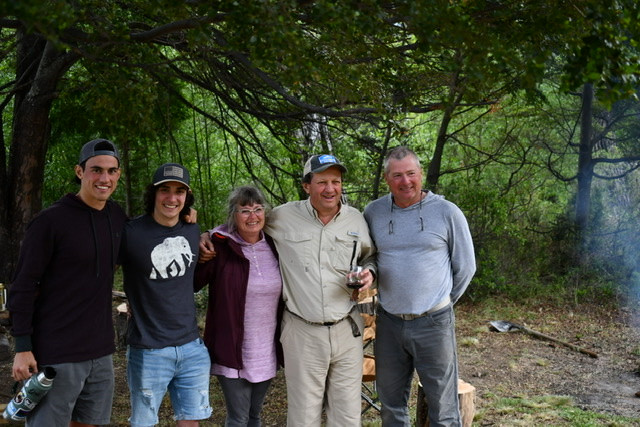
During one mid-day asado we were unexpectedly surprised by a convoy of three Toyota Hilux trucks bearing the Patagonia River Guides logo. Out popped a family of Argentines we had hosted in Alaska several years ago. They were staying at PRG‘s Rio Pico Lodge, located about 120 km south of our position. They have heard we were in the area and had taken time from their vacation to travel north to see us in person. It was flattering to see them and it was a joyful reunion.
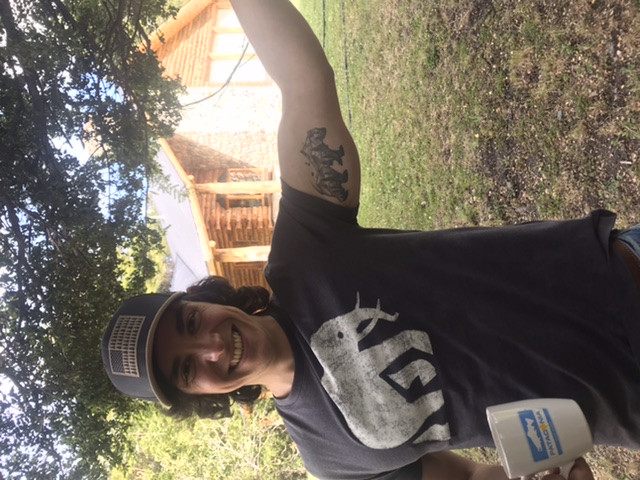
If I have ever doubted the impact we have upon peoples lives through our work in Alaska, it was erased right then and there when one of the family sons held up his arm to proudly show us a tattoo of a bear he had done on his inner bicep to commemorate his Alaskan vacation.
When Tuesday arrived we made our way back to Trevelin to inquire with the local auto parts store about getting a plug to replace those damaged by the gray water tanks departure. We also needed a fuse because when the wire drug along the gravel road it shorted the electrical system.
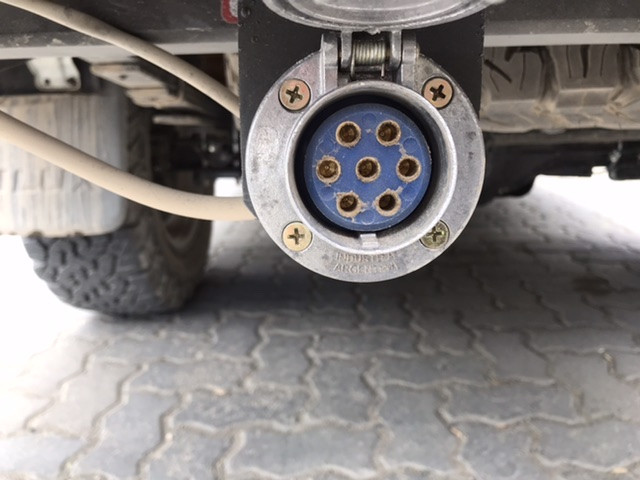
I took a photo of the female end of the cord attached to the truck and produced the remains of the male end of the plug to the first store we visited. No, they didn’t carry it, but wait, how about this one? Close, but no cigar. We continued onward the additional 30 km to Esquel.
Lunchtime was closing in on us. Argentine lunch runs from approximately noon to four every workday. The entire country literally closes and goes home for the main meal and resting period of the day. We inquired at one store: No, but two blocks down is a place that will have it.
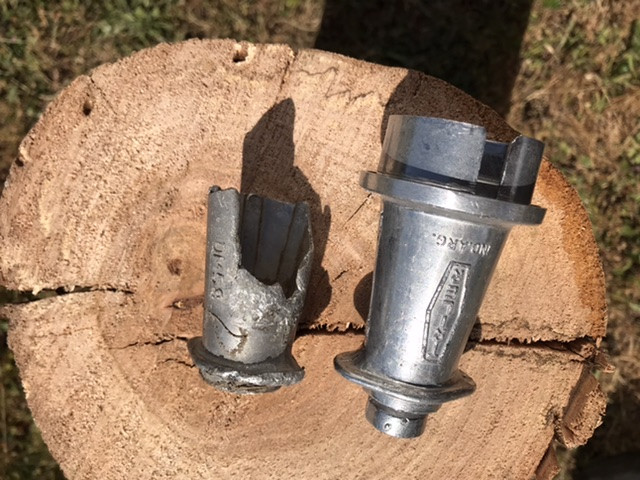
On we went to find a building with signs advertising not only auto parts but specialty electronics for cars and trucks. Bingo. They had it. They showed us how it installed. We checked it on our truck by plugging it in to make sure it was the correct one. It fit. The closed sign went up on the auto parts store door and we watched the city streets fill with traffic of people going home for lunch. It occurred to us this country has four rush hours per day.
We needed to either get advice on how to install the correct wiring sequence on the plug or buy more tools; so we could undertake a long trial-and-error process of figuring it out with an electronic tester. Resourcefulness won the day. Knowing our camper dealer, Patagonia Campers of Buenos Aires had done the job before, we called the owner, Alejandro. Through the clinking of silverware hitting bone china in the background, Alejandro explained he was in Chicago having Breakfast. His brother, Andres, handles the technical aspects of installations at the dealership in Buenos Aires and I asked Alejandro for Andres telephone number. Alejandro explained Andres was sitting right next to him at the breakfast table and passed the phone.
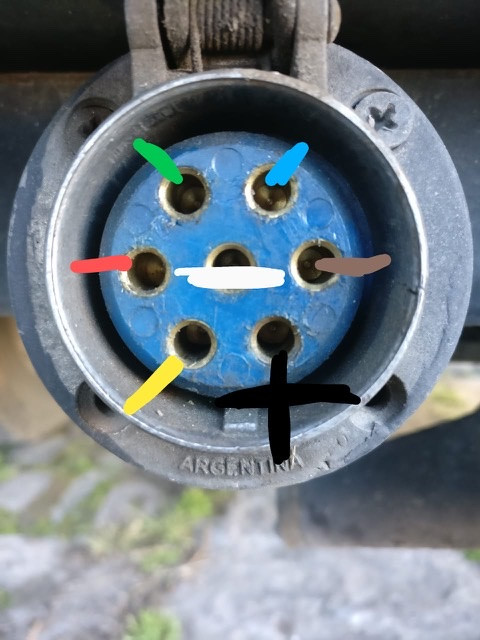
Andres told me he had a wiring diagram photo with instructions on his telephone and he would send it to me immediately via WhatsApp, the preferred VOP and text protocol of this part of the world.
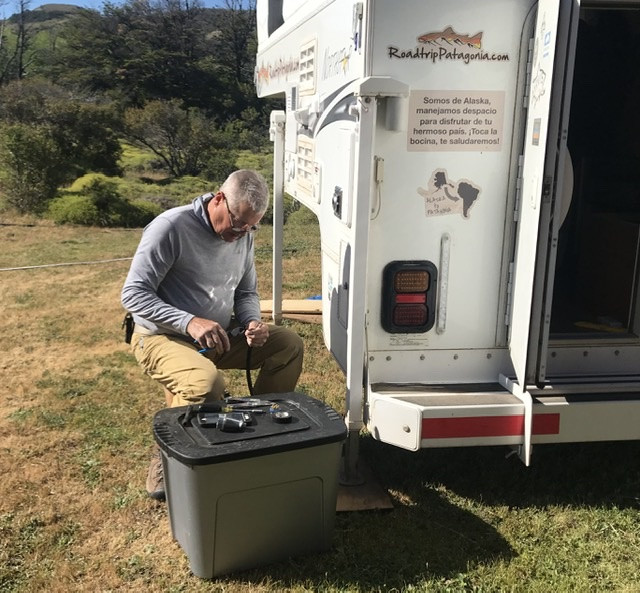
We drove back to the estancia and, with a screwdriver, a wire cutter, our new plug, electrical tape AND the diagram on the iPhone we had the new plug cleanly installed within 30 minutes. We tested it and it worked perfectly.
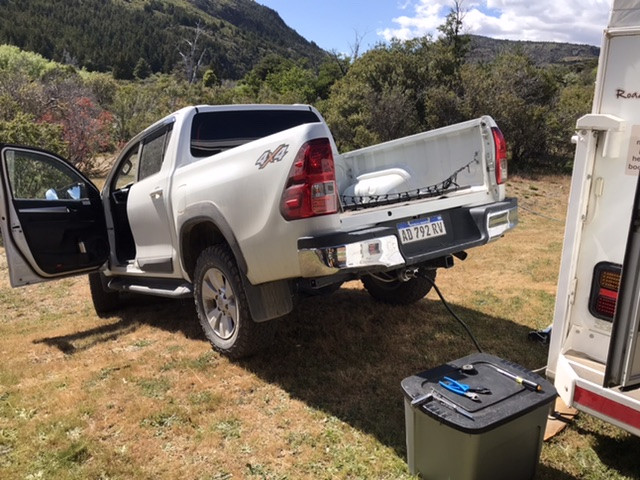
That’s the story of how two people from Alaska stranded on an estancia in rural Argentina with a broke camper made in Iowa were able to fix their electrical system with help from a guy from Buenos Aires having breakfast in Chicago.
